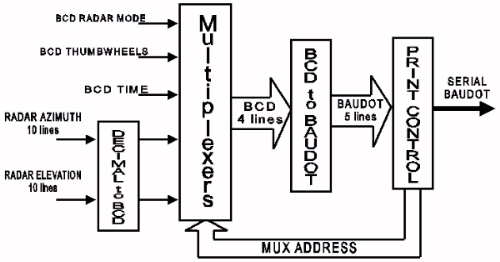Technical details
The Raprint allowed tracking data from WF3 radars to be printed on a teleprinter along with elapsed time and radar status information. The 50 baud teleprinter ran on its own 40mA single current loop connection and was fed from a mercury-wetted teleprinter relay in the Raprint Control module.
The unit was built in an "Elmaset" brand 19" 3 rack unit standalone cabinet. The left half contained a card cage and the right side housed the Control Module. This module slid in from the front and then a large jacking screw at the rear was turned to pull the module into connection with the frame mounted connectors. Unfortunately it was all to easy for misalignment to occur and the result was connectors with flattened pins!!
The Control Module
The Control Module contained the front panel controls; print time interval,
thumbwheel code switches, time display and the audiable alarm. It also housed
the power supplies and the teleprinter drive relay.
The elapsed time was displayed on a red led display with brightness control
and the selection of print interval was made from a set of interlocked push-button
switches. The audible warning which sounded for six seconds prior to printout
cam from a Sonalert unit. An arbitrary two digit code was printed as set on
two thumbwheel switches and a single digit code indicated whether the radar
was under visual, Auto or manual control at the time of printout.
Radar connections
The radar interfacing was designed to match the mixture of available signals
of the WF3. The range data was fed as parallel BCD at TTL levels and the angle
data as parallel decimal 12 volt logic.
Within the Rapint
After interfacing and code conversion, a four line binary code system was used
providing 16 available characters. binary 0 - 10 were used for those decimal
numbers and binary 11 to 15 were used for the control characters such as "space',
" figure shift" etc.
The 20mS timing for the teleprinter output was provided from a crystal source.
The Extras
As always with the in-house designed units, provision was made for timing signals
for other purposes. For example, a one minute contact closure could be used
to control an event marker on a radiosonde chart recorder.
|
Block Diagram
|
 |